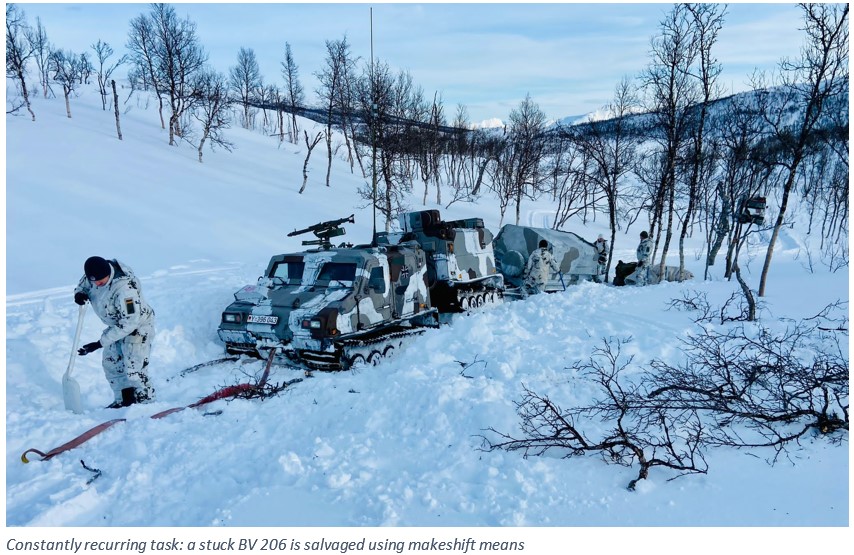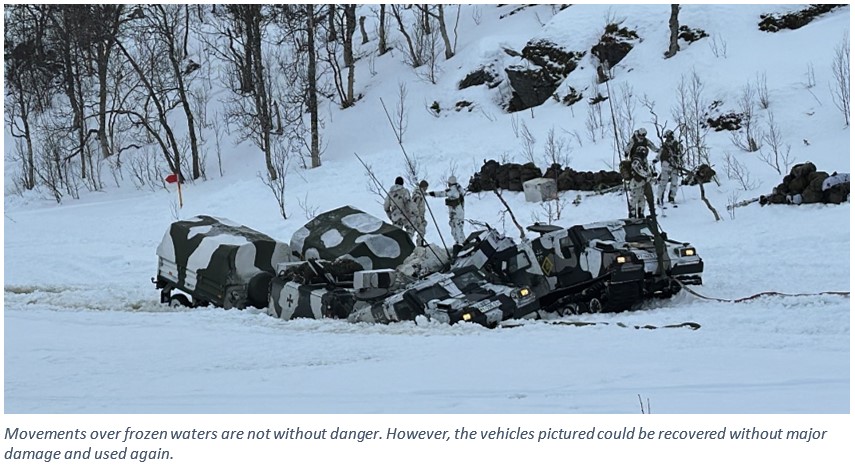WINTER COMBAT NORTH OF THE ARCTIC CIRCLE
External Author2024-04-10T14:30:11+00:00After the end of the AMF exercises in the mid-1990s, the Mountain Infantry Battalion 233 was the first unit in the German Armed Forces to train again at battailion size during the winter north of the Arctic Circle as part of the multinational NORDIC RESPONSE 2024 exercise. As a result of previous training deployments as part of the “EISKRISTALL” exercise series, the leaders/instructors, and in particular the Army Mountain Guides, already had a wealth of experience, which – as was demonstrated during the exercise – was enriched by numerous new experiences and challenges.
The NORDIC RESPONSE 24 exercise was based on a classic Alliance defence scenario. In essence, it involved an aggressor from the east attempting to invade and occupy Finnmark – an area in northern Norway – in order to gain a strategic advantage for its nuclear submarine fleet based at the Kola Peninsula. In other words, it was a realistic scenario that had to be taken seriously, and none of the participants had to be made aware of or motivated due to its military strategic relevance. A special feature of the exercise was that the German Mountain Infantry Battalion 233 was subordinated to the Norwegian Brigade North (Operational Command [OPCOM]) for the exercise, partly to compensate for the lack of over-snow capabilities there.
The battalion’s mission outlines the resulting challenges: Attack over 50 km in one day, according to the plan, in an isolated combat zone on a high plateau with no infrastructure except for a dirt road under the snow cover.
Added to this were the arctic conditions on the Finnmark plateau, about 25 kilometres south of the Altafjord. In general, the vegetation at these latitudes is moderate: small birch trees with a maximum trunk diameter of few centimetres and a height of a few metres. The tree line is about 300 metres above sea level, and small differences in altitude have a strong effect in this predominantly flat, locally limited moderately steep terrain with a low alpine character. The long lines of sight on the plateau, with its extensive elevations, severely limit the operational value of dismounted infantry. In addition, the lack of vegetation, the absence of landmarks and the difficult lighting conditions due to the weather and time of day made orientation a real command and control task. The numerous hills and ridges, which were not particularly distinguishable from one another, could not be used as landmarks, despite the mostly excellent weather. As a result, the high operational tempo of the mechanised battalion attacking in the adjacent battlefield could only be ensured by intensive use of the GPS – especially as the neighbour was attacking along an asphalt road with Leopard MBT‘s and CV-90‘s (Infantry fighting vehicle).
Although the risk of avalanches was completely eliminated within the Area of Operation, the snow cover still proved to be a tough opponent both people and vehicles. Due to the strong winds, the snow was extremely dense in places, hard in others and almost completely blown away in others. Mild temperatures, hovering around freezing for several weeks, have resulted in a fist-thick layer of hard snow everywhere, under which the crystals have transformed into a layer of powdery snow up to a metre thick. This layer of granular snow, which the Norwegians call “sugar snow”, posed a major challenge in terms of movement. Tracked vehicles such as the BV 206 in both variants, but also skidoos, had little traction, especially on sloping terrain. Due to their weight with all the combat equipment, even dismounted soldiers on skis often broke through the layer of hard snow and only emerged from the layer of gritty snow with great difficulty. Some of them were sunk in up to their knees. These difficult conditions were particularly noticeable away from the snow-covered ground, which was often damp and muddy. This underlines the importance of a high level of physical fitness to survive in these difficult conditions. Preparation in the mountains under almost comparable conditions is essential. Training in the local mountains as part of the preparation for the exercise in Norway proved extremely helpful. In order to be able to survive and fight in difficult terrain under extreme weather conditions, the handling of equipment (skis, clothing) must be trained and practised in advance, in addition to the special tactical requirements. The mountains, with their peculiarities and characteristics, offer the best conditions for this. Those who have trained and practiced to survive and fight in the mountains will also be able to fulfil their mission in the High North.

Due to an overall disproportionately warm temperatures, an additional phenomenon, well-known in the alpine region, occurred, catching initially everyone off guard in the north in March: the daytime warming of the snowpack and the associated saturation. This made movements in the afternoon nearly impossible, and the same principle applied as it does in late winter ski tours: The early bird catches the worm.
Another topic that has almost lost its relevance in Germany and other countries due to global warming is the assessment of the carrying capacity of frozen waters. The Norwegian Army has its own evaluation and assessment system for the inevitable crossing of the country’s many lakes. Despite this, crossing water, especially with vehicles larger than a skidoo, is avoided as much as possible by the Norwegians. The units experience in this area is limited and will have to be built up in the coming years, as this issue is also of great importance in other possible operational areas of the new NATO partners Sweden and Finland.

The expertise of an Military Mountain Guide in such an operation is therefore required in a slightly different way than, for example, during a combat exercise at the Wattener Lizum (military training area in Austria) or during a march in wintery conditions. It is not primarily about avalanche assessment and the resulting choice of the best and safest ascent route, or knowledge of provisional mountain rescue. Rather, it is about providing advice, especially to the company commander during planning and operations, and technical skills as a group and section leader. The many experiences from different types of terrain had to be transferred to the prevailing environmental conditions. As already mentioned, this primarily concerned orientation and the choice of vehicle route according to the assessment of the snow cover. The use of experienced Military Mountain Guides in the reconnaissance and combat patrols proved just as effective as the use of light skidoos to scout the route ahead. This knowledge was used for the rescue of snowbound vehicles, rather than the provisional rescue of casualties. It can be said that the Military Mountain Guide and the Driving Instructor in the company must ensure that the drivers of the BV 206 as well as the Skidoo are trained and further trained, ideally in open, impassable terrain, primarily in Scandinavia, as similar conditions are almost non-existent in Central Europe, provided that the probable area of operation of the Mountain Infantry Brigade is located there.
At unit level, as in operations in mountainous terrain, the main advisory role of the Military Mountain Guide is risk management. For this purpose, it is advisable to set up a separate small section, the Mountain Cell, at least from battalion level upwards. The mountain cell, led by an Military Mountain Guide, is responsible for assessing the risks posed by terrain influences (e.g. mountain hazards, weather, load-bearing capacity of snow and ice surfaces) in relation to the area of operations and the prevailing geographical features, and advising the tactical commander (ground force commander) on possible effects/impacts on the conduct of operations.
The use of vehicles at night during the exercise had to be considered very carefully due to the high risk of injury caused by the adverse snow conditions, and assessed against the potential success of the operation. A consideration that would certainly lead to a decision not to use vehicles at night in case of an exercise. Due to the unexpectedly mild and stable weather, there was no need to take any further action that would have had an impact on the operation.
In summary, the experience gained during NORDIC RESPONSE 24 has led to a considerable amount of knowledge, but it is certainly not fully transferable to other operations and exercises in the Arctic environment. As is so often the case, everything depends on the climatic processes and especially on the weather.


